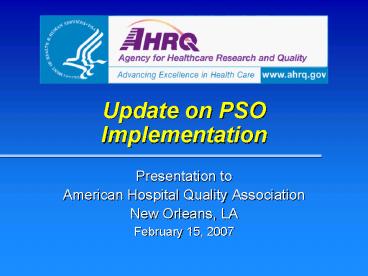Update on PSO Implementation - PowerPoint PPT Presentation
1 / 22
Title: Update on PSO Implementation
1
Update on PSO Implementation
- Presentation to
- American Hospital Quality Association
- New Orleans, LA
- February 15, 2007
2
Todays Patient Safety Baseline
- Are patients safer now? Data from neither the
entire US health care system nor the individual
hospitals can yield a credible answer. - JAMA - August 9, 2006
- Pronovost PJ, Miller MR, Wachter RM. Tracking
Progress in Patient Safety an elusive target.
JAMA. 2006296696-699.
3
Where have we been?
- November 1999 IOM Releases To Err is Human
- 2000 Congress begins debate on event reporting
legislation - 2001-2004 Congress directs AHRQ to fund reporting
demonstration projects - 2005 Congress passes The Patient Safety and
Quality Act (PSIQA) - September 2005 AHRQ begins drafting regulations
4
Where are we going
- March 2006 AHRQ holds public listing sessions for
public input - December 2006 AHRQ and Office of Civil Rights
submits draft regulations to the Office of the
Secretary of HHS - Winter 2007 OS sends regulations out for HHS
review - Next stop OMB
- Release NPRM?
- Release Final Regulations ?
- Establish PSO?
5
Patient Safety Act of 2005
- Creates Patient Safety Organizations (PSOs)
- Establishes Network of Patient Safety Databases
- Requires reporting of findings annually in AHRQs
National Health Quality/Disparities Reports - Mandates Comptroller General to study
effectiveness of Act (by 2010)
6
PSQIA PL 109-41
- Amends AHRQs enabling legislation
- AHRQ will administer program
- Office of Civil Rights will handle enforcement
- Program is voluntary
- Purpose of Act
- To improve patient safety
- To reduce the incidence of events that adversely
affect patient safety
7
Problems Law Addresses
- Fear of malpractice litigation
- Inadequate protection by state laws
- Inability to aggregate data on a large scale
8
How Law Addresses Problems
- Authorizes creation of PSOs they enter into
contracts with providers to assist them to
analyze threats to patient safety to reduce or
prevent them - Requires PSOs to work with more than one provider
so that PSOs can aggregate data across providers - Provides Federal privilege/confidentiality
protection for analyses reports significantly
limits their use in criminal, civil,
administrative proceedings
9
Patient Safety Organizations (PSOs)
10
Who Can be a PSO?
- Eligible organizations
- Public or private entities
- Profit or not-for-profit entities
- Provider entities, such as hospital chains
- Other entities that establish components
- Ineligible organizations
- Insurance companies or their affiliates
11
Types of PSOs
- PSOs may be free-standing or a component of
another organization (such as a provider system) - Component PSOs must meet additional criteria
- Maintain separate operations from parent
organization - No unauthorized disclosures to parent
organization - Mission does not create conflict of interest with
parent
12
PSO Activities
- Collect, analyze patient safety (PS) data
- Assist providers to improve quality safety
- Develop disseminate PS information
- Encourage culture of safety minimize patient
risk - Operate PS evaluation systems provide feedback
to participants - Maintain confidentiality security of PS data
13
In the Mean Time
Network of Patient Safety Databases (NPSD)
14
NPSD
- Simplifies task of reporting events
- Employs common formats (definitions, data
elements, etc.) promotes interoperability - Generates de-identified information relevant to
preventing harm to patients - Aggregation of data
- Analysis of events, profiles, reports
- Dissemination of results, best practices
- Provides benchmarking trend reports
15
AHRQ Inventory of Reporting Systems
- Begun in January 2005
- Establishes evidence base for development of
common definitions formats - Includes representation from many operating
systems other stakeholders
16
Inventory Scope
- Federal
- State
- Collaborative entities (e.g., ECRI, JCAHO)
- Institutions (e.g., hospital chains)
- Commercial off-the-shelf software systems
- International (e.g., AIMS, NPSA)
- Standards development organizations
17
Inventory Content
- Reporting system descriptions
- Reporting items
- Data elements
- Definitions
- Encoding schemes
18
Inventory of Reporting Systems
19
AHRQ Inventory of Reporting Systems
- Preliminary findings
- Commonality found for some definitions
- Variability found for many
- Few systems collect information on complete
improvement cycle
20
Common Format Development
- Begin with representatives of Federal agencies
with reporting systems - DoD, CDC, FDA, VA, others
- Codify analyze AHRQ inventory database
- Develop initial common formats, definitions for
provision to PSOs - Involve interested parties from the private
sector in refinement maintenance
21
Our Next Steps
- Develop publish rules governing certification
operation of PSOs - Operational section AHRQ
- Enforcement section OCR
- OMB regulatory forms - AHRQ
- Review PSO applications publish list of PSOs
whose certifications are accepted - Provide common formats to PSOs
22
- Questions/Discussion
James B Battles, PhD Center for Quality
Improvement and Patient Safety 540 Gaither
Road Rockville, MD 20850 Phone (301)
427-1332 Email james.battles_at_ahrq.hhs.gov































